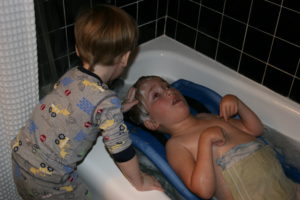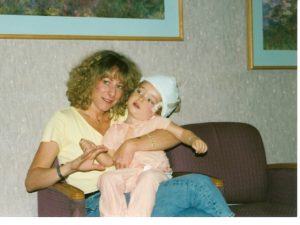A Brother’s Love Fights Genetic Disease
Gene therapy has been in the news recently, for awards. The same day that publisher Mary Ann Liebert Inc. honored 12 “pioneers in gene therapy,” one of the youngest patients, 13-year-old Corey Haas, won school-wide and district-wide essay contests, writing about life with sudden vision, thanks to gene therapy at age 8.
Another type of gene therapy award is the recently-announced support for both preclinical research and clinical trials from several family-run not-for-profits, whose bike races and bake sales and expertly-assembled research conferences are filling in some of the gaps left from dwindling government resources.
This post honors a very special young man who represents the siblings of the kids undergoing gene therapy. Eleven-year-old Alex Randell just won the Heart of Buffalo Grove Youth Volunteer Award, in his Illinois hometown. According to the announcement, “Alex has made it his main duty to protect his brother.”
 Alex’s 16-year-old brother Max has Canavan disease. It’s one of the 19 “Jewish genetic diseases,” but of course DNA can’t sense the religious persuasions of its owner, and can affect anyone. Two carrier parents pass on Canavan disease. It is deficiency of an enzyme (aspartoacylase) needed in the brain to break down a biochemical (N-acetyl aspartic acid) into pieces that are then used to make myelin, the fatty sheath that coats neurons. Without myelin, nerve transmission wouldn’t be fast enough.
Alex’s 16-year-old brother Max has Canavan disease. It’s one of the 19 “Jewish genetic diseases,” but of course DNA can’t sense the religious persuasions of its owner, and can affect anyone. Two carrier parents pass on Canavan disease. It is deficiency of an enzyme (aspartoacylase) needed in the brain to break down a biochemical (N-acetyl aspartic acid) into pieces that are then used to make myelin, the fatty sheath that coats neurons. Without myelin, nerve transmission wouldn’t be fast enough.
A child with Canavan disease grows and develops, but as the white matter of the brain becomes a spongy mass of fluid-filled bubbles, he or she never walks, talks, or even rolls over. But the intellect remains sharp. One little girl, the first to receive gene therapy, reacted to a housekeeper’s Spanish as well as to her parents’ English. And just a look at Max’s face reveals that he is alert and engaged. DNA Science from about a year ago gives more details on the biology of Canavan disease.
I first read about Max Randell in an article in The Scientist in 2001, in a front page story by my friend Doug Steinberg. I was working on the upcoming edition of my human genetics textbook, and interviewed Max’s mom, Ilyce, to tell their story in the chapter that includes gene therapy.
Max had two gene therapies that improved his vision and mobility. I’ve updated his story with each new edition, happy that he was living well beyond what the doctors had predicted. I had the honor of attending his 13th and 15th birthday parties.
Alex’s earliest memories are of his mom on the phone with Paola Leone, PhD, Director of the Cell & Gene Therapy Center at the Rowan School of Osteopathic Medicine in Stratford, NJ. Dr. Leone led the gene therapy trials for Canavan disease. Today she is working with researchers at St. Jude’s Children’s Research Hospital on a gene therapy that will be much less invasive than the gene delivery through six holes in the head that Max and other kids experienced a decade ago.
Alex began his fundraising career early. By the age of 2½, he was stuffing envelopes and making short speeches for Canavan Research Illinois, coached by “Grandma Peggy” Shapiro, who is an actress.
At age 7, Alex read about Max’s gene therapy in my textbook and became upset over my description of Canavan disease as being lethal by age 8. His brother had already proven me wrong. I took that part out.
 At age 10, Alex told me about a study he’d read in which the control group was not adequate, demonstrating a grasp of scientific method I hadn’t seen among college students. (I was spending an afternoon with the family, who’d rescued me from a boring conference I was covering in Chicago.)
At age 10, Alex told me about a study he’d read in which the control group was not adequate, demonstrating a grasp of scientific method I hadn’t seen among college students. (I was spending an afternoon with the family, who’d rescued me from a boring conference I was covering in Chicago.)
And last Memorial Day, Alex’s audience wasn’t the hundred or so attendees of Max’s annual birthday bash, but scientists from the National Institute of Neurological Disorders and Stroke. He traveled to Bethesda, Maryland with his mother to tell Max’s story. Unfortunately, Alex’s moving speech didn’t catalyze funding as hoped, and in fact some research has stalled.
Next year, Alex will plan the youth part of the annual birthday event. “I’m doing the fundraising because I haven’t graduated college yet to pursue a career as a researcher,” he told me last week. “I want to work on neurodegenerative disease, but I hate that word.”

Alex does kid things too. He wrestles and plays the trumpet, and loves sixth grade because classes change and he can chat with friends in the halls. Max, he says, is both funny and smart. “He really likes loud noises. When someone sneezes or crashes dishes, he starts laughing. He’s really funny. He blinks for yes and kind of moves his eyes back and forth for no,” Alex explains. Max earns good grades, and graduated from middle school in 2012.
The family likes to talk about Max’s “healing powers.” “When someone isn’t feeling too well in the family we ask him to use them and he starts laughing and in a couple of hours the person feels better. It’s not explainable, it’s just there.”
Alex has always loved reading to his brother, and he’s taking over more of Max’s care.
“When my mom is doing charity work in her office, we hang out and watch TV together. I can set up his nebulizer but I can’t set up his compression vest because that’s a two-man job. He has to get lifted up and the vest placed around him, but I can take it off and start it up and I know how long the cycles go for. I’m still working on suctioning, so he can breath easier,” Alex told me. And he can be home alone with Max for longer times.
“Max is my hero. There’s nothing he can do to be a better brother than to just be himself. How I feel about Max is beyond words. I’m lucky to have him.”
I’d say the Randell family is lucky to have two wonderful boys.


This is so inspiring, thank you for sharing it to us. Both of them are not the typical kids you would see nowadays, especially Alex. Kudos to Alex who at such a young age have managed to take good care of his brother and have such a commitment to help other people than to benefit his own self. I know that one day, his dream to be a medical researcher will come true and hoping that he will contribute to the advancement of medicines to find cure for genetic disorder in the future.